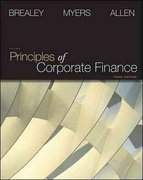Term loans usually require firms to pay a fluctuating interest rate. For example, the interest rate may
Question:
Term loans usually require firms to pay a fluctuating interest rate. For example, the interest rate may be set at “1% above prime.” The prime rate sometimes varies by several percentage points within a single year. Suppose that your firm has decided to borrow $40 million for five years. It has three alternatives. It can ( a ) borrow from a bank at the prime rate, currently 10%. The proposed loan agreement requires no principal repayments until the loan matures in five years. It can ( b ) issue 26-week commercial paper, currently yielding 9%.
Since funds are required for five years, the commercial paper will have to be rolled over semiannually. That is, financing the $40 million requirement for five years will require 10 successive commercial paper sales. Or, finally, it can ( c ) borrow from an insurance company at a fixed rate of 11%. As in the bank loan, no principal has to be repaid until the end of the five-year period. What factors would you consider in analyzing these alternatives?
Under what circumstances would you choose ( a )? Under what circumstances would you choose ( b ) or ( c )? ( Hint: Don’t forget Chapters 3 and 23.)
AppendixLO1
Step by Step Answer:






